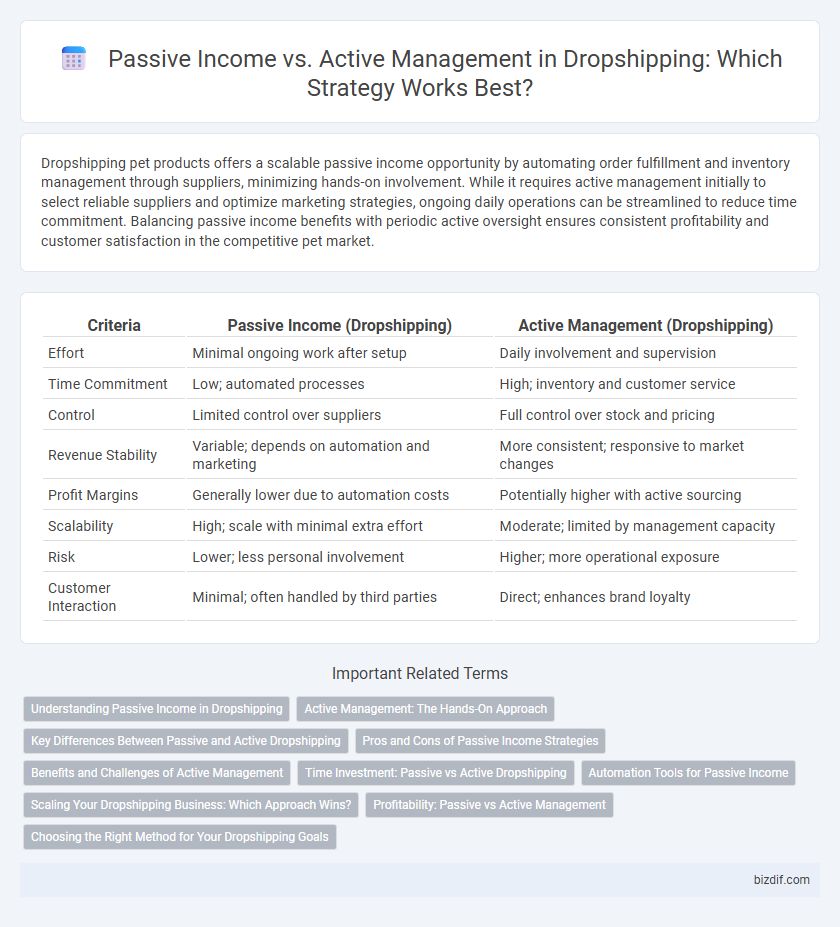Dropshipping pet products offers a scalable passive income opportunity by automating order fulfillment and inventory management through suppliers, minimizing hands-on involvement. While it requires active management initially to select reliable suppliers and optimize marketing strategies, ongoing daily operations can be streamlined to reduce time commitment. Balancing passive income benefits with periodic active oversight ensures consistent profitability and customer satisfaction in the competitive pet market.
Table of Comparison
| Criteria | Passive Income (Dropshipping) | Active Management (Dropshipping) |
|---|---|---|
| Effort | Minimal ongoing work after setup | Daily involvement and supervision |
| Time Commitment | Low; automated processes | High; inventory and customer service |
| Control | Limited control over suppliers | Full control over stock and pricing |
| Revenue Stability | Variable; depends on automation and marketing | More consistent; responsive to market changes |
| Profit Margins | Generally lower due to automation costs | Potentially higher with active sourcing |
| Scalability | High; scale with minimal extra effort | Moderate; limited by management capacity |
| Risk | Lower; less personal involvement | Higher; more operational exposure |
| Customer Interaction | Minimal; often handled by third parties | Direct; enhances brand loyalty |
Understanding Passive Income in Dropshipping
Passive income in dropshipping involves automating tasks such as order processing, inventory management, and customer service using tools like Shopify apps and third-party logistics providers. Active management demands continuous attention to market trends, supplier relationships, and advertising campaigns to maintain profitability and growth. Understanding passive income requires recognizing that while automation reduces daily workload, initial setup and periodic oversight are essential for sustained success.
Active Management: The Hands-On Approach
Active management in dropshipping requires continuous monitoring of inventory, pricing strategies, and supplier performance to maximize profitability. Entrepreneurs engage directly with customer service, marketing campaigns, and trend analysis to adapt rapidly to market demands. This hands-on approach accelerates growth potential by allowing precise control over business operations and responsiveness to customer needs.
Key Differences Between Passive and Active Dropshipping
Passive dropshipping requires minimal daily involvement, relying on automation tools and third-party suppliers to handle order fulfillment, while active dropshipping demands hands-on management, including product selection, customer service, and inventory monitoring. Income from passive dropshipping tends to be more stable but slower to scale, whereas active dropshipping offers higher control and faster growth potential with increased time investment. Key differences revolve around time commitment, control over operations, and scalability opportunities in each model.
Pros and Cons of Passive Income Strategies
Passive income strategies in dropshipping allow entrepreneurs to generate revenue with minimal daily involvement, leveraging automation tools and outsourced tasks to scale efficiently. The primary advantage is time freedom and consistent cash flow, though the downsides include less control over customer service quality and difficulties in quickly adapting to market changes. Risks also involve dependency on third-party platforms and potential challenges in maintaining long-term profitability without active management.
Benefits and Challenges of Active Management
Active management in dropshipping allows entrepreneurs to optimize product listings, adjust pricing, and respond quickly to market trends, enhancing profit potential and customer satisfaction. The hands-on approach demands consistent effort, time investment, and rapid decision-making to manage suppliers, fulfill orders, and address customer inquiries effectively. While it offers greater control over business growth and flexibility, active management may lead to increased stress and operational complexity compared to passive income models.
Time Investment: Passive vs Active Dropshipping
Passive dropshipping requires minimal time investment since most tasks like order fulfillment and customer service are outsourced or automated, allowing entrepreneurs to focus on scaling and marketing efforts. Active dropshipping demands significant time commitment for inventory management, supplier communication, and handling customer inquiries, resulting in more direct control but higher daily involvement. Choosing between passive and active dropshipping depends on available time resources and desired operational control within the business model.
Automation Tools for Passive Income
Automation tools in dropshipping, such as inventory management software, automated order processing, and AI-driven customer service chatbots, significantly reduce the need for active management. These technologies streamline daily operations, enabling entrepreneurs to generate passive income by minimizing manual tasks and operational bottlenecks. Leveraging platforms like Oberlo, AutoDS, and Dropified enhances scalability and efficiency, making dropshipping a more sustainable source of passive revenue.
Scaling Your Dropshipping Business: Which Approach Wins?
Scaling your dropshipping business requires evaluating passive income strategies versus active management methods for sustainable growth. Passive income relies on automated systems and outsourced tasks, enabling scalability with minimal daily involvement, while active management demands hands-on oversight, quick decision-making, and continuous optimization. Businesses that combine strategic automation with targeted active interventions often achieve the highest revenue growth and operational efficiency in competitive markets.
Profitability: Passive vs Active Management
In dropshipping, profitability varies significantly between passive income models and active management approaches. Passive income relies on automated systems and minimal daily involvement but often yields lower profit margins due to limited optimization and slower response to market trends. Active management demands consistent engagement, including inventory adjustments, customer service, and marketing strategies, resulting in higher profitability through quicker adaptation and improved operational efficiency.
Choosing the Right Method for Your Dropshipping Goals
Passive income in dropshipping relies on automation tools and outsourced tasks, enabling store owners to generate revenue with minimal daily involvement, ideal for those seeking long-term income with less time commitment. Active management requires hands-on control of product selection, customer service, and marketing strategies, offering greater flexibility and faster adaptation to market trends but demanding significant time investment. Selecting the right method depends on your business goals, available time, and willingness to engage with operational details, balancing between scalable automation and personalized oversight.
Passive income vs active management Infographic

 bizdif.com
bizdif.com